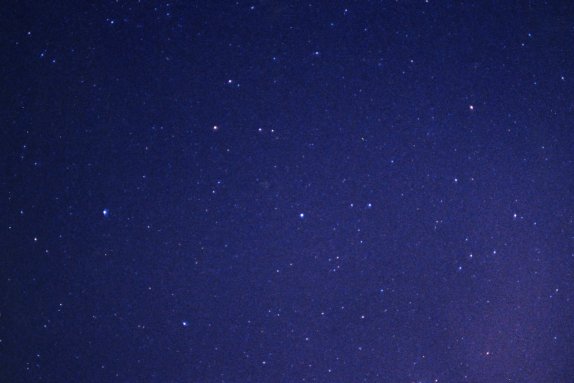 Pegasus, the Flying Horse, stretches from left to right, its
most obvious feature the
Great Square seen to the left of center, here oriented as a diamond.
The bright star toward the left edge is Alpheratz (Alpha Andromedae), which connects
the Great Square with Andromeda.
Scheat, Beta Pegasi, is at the top of the Square,
with Sadalbari (Mu and Lambda) just to the right of it, while Algenib is at
the bottom. The constellation continues to the right of Markab at the right-hand corner of
the Square ending in Enif, the bright star toward upper right.
Matar is just above and to the right of Scheat. Look up and to the right of Matar
to find Iota, then up and to the right of Iota to get to Kappa. To the immediate right
of Markab are Xi Pegasi and Homam (Zeta), followed by Biham (Theta) and Nu. The pair of stars that
make Pi Pegasi is at the top center edge of the picture and also appears on the image
of Lacerta, where they are resolved. Psi is to the right and a bit down from
Alpheratz, while Chi is up and to the left of Algenib. Sigma then Rho are on a vertical line
down and to the right of Xi. 56 Peg is down and to the right of Scheat.
Pegasus, the Flying Horse, stretches from left to right, its
most obvious feature the
Great Square seen to the left of center, here oriented as a diamond.
The bright star toward the left edge is Alpheratz (Alpha Andromedae), which connects
the Great Square with Andromeda.
Scheat, Beta Pegasi, is at the top of the Square,
with Sadalbari (Mu and Lambda) just to the right of it, while Algenib is at
the bottom. The constellation continues to the right of Markab at the right-hand corner of
the Square ending in Enif, the bright star toward upper right.
Matar is just above and to the right of Scheat. Look up and to the right of Matar
to find Iota, then up and to the right of Iota to get to Kappa. To the immediate right
of Markab are Xi Pegasi and Homam (Zeta), followed by Biham (Theta) and Nu. The pair of stars that
make Pi Pegasi is at the top center edge of the picture and also appears on the image
of Lacerta, where they are resolved. Psi is to the right and a bit down from
Alpheratz, while Chi is up and to the left of Algenib. Sigma then Rho are on a vertical line
down and to the right of Xi. 56 Peg is down and to the right of Scheat.
The "Water Jar" of Aquarius is below Enif, the "Circlet" of Pisces is below Markab, while the quartet of stars that make Equuleus is at the upper right corner. The globular cluster M 15 is the top of the two faint "stars" that are pointed to on line from Biham to Enif..
